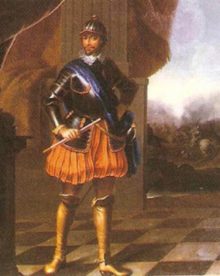Fernando II, Duke of Braganza
This article includes a list of general references, but it lacks sufficient corresponding inline citations. (April 2017) |
| Fernando II | |
|---|---|
 D. Fernando II; Vila Viçosa Castle | |
| Duke of Braganza | |
| Tenure | 1 April 1478 – 20 June 1483 |
| Predecessor | Fernando I |
| Successor | Jaime I |
| Born | 1430 Kingdom of Portugal |
| Died | 20 June 1483 (aged 52–53) Évora, Alentejo, Kingdom of Portugal |
| Spouse | Leonor de Menezes Isabella of Viseu |
| Issue among others... | Jaime I, 4th Duke of Braganza Dinis, 6th Count of Lemos |
| House | House of Braganza |
| Father | Fernando I |
| Mother | Joana de Castro |
| Religion | Roman Catholicism |
Dom Fernando II of Braganza (Portuguese pronunciation: [fɨɾˈnɐ̃du]; 1430 – 20 June 1483) was the 3rd Duke of Braganza and the 1st Duke of Guimarães, among other titles. He is known for being executed for treason against the King.
Early life

Fernando II, born in 1430, was a successful young man and quickly grew popular amongst the Portuguese nobility. He was most appreciated by King Afonso V of Portugal, and always escorted the King on his different incursions into Morocco, where he participated in several conquests and expeditions. Being favored by King Afonso V, Fernando was created Count of Guimarães in 1464. He was soon upgraded to Duke of Guimarães in 1475.
Fernando II took part in the War of the Castilian Succession. Following King Henry IV of Castile's death, the King's daughter and heir, Joanna La Beltraneja, married to King Afonso V, was proclaimed "Queen of Castile", but she had the opposition of her half-aunt (the future queen Isabella I of Castile) to contend with. The Portuguese invaded Castile, and during the Battle of Toro, Fernando was responsible for Queen Joanna’s safety.
When his father, Fernando I, 2nd Duke of Braganza, died in 1478, Fernando II inherited the various titles of his father, the most important and noteworthy being the title of Duke of Braganza. At this time, the House of Braganza was the most powerful noble house in the Kingdom of Portugal (with its seat at Vila Viçosa) and one of the most powerful ones in all of the Iberian Kingdoms. During that period, the Dukes of Braganza resided at Vila Viçosa Castle.
Treason and downfall
When King John II of Portugal succeeded his father, King Afonso V, he sought to bring down the power of the Portuguese nobility, which had greatly flourished under his father's reign. The King heavily focused on diminishing the powers of the two most powerful noble houses in the kingdom, House of Beja and Viseu and the House of Braganza.
King John II accused his first cousin, Diogo I of Beja and Viseu (brother-in-law of Fernando II), of high treason and had him brutally executed. Soon after, the King also accused his second half-cousin, Fernando II of Braganza, of high treason and had him executed at Évora in 1483. Afterwards, the assets of the House of Braganza were confiscated and the family fled to Castile.[1] The family returned in 1498 and had all their property returned.
Marriage and issue
Fernando II of Braganza married twice. His first marriage was to D. Leonor de Menezes; they had no issue. He later married Isabella of Viseu (daughter of Prince Ferdinand, Duke of Beja and Viseu, and sister of King Manuel I of Portugal) in 1472, with whom he had four children, though only two lived past infancy.
| Name | Birth | Death | Notes |
|---|---|---|---|
| Filipe of Braganza | unknown | unknown | Still born |
| Jaime I of Braganza | October 1479 | 20 September 1532 | 11th Count of Barcelos, 8th Count of Ourém, 5th Count of Arraiolos and Neiva, 4th Duke of Braganza, 3rd Marquis of Vila Viçosa, 2nd Duke of Guimarães |
| Dinis of Braganza | 1481 | 1516 | 6th Count of Lemos |
| Margarida of Braganza | unknown | unknown | Still born |
Ancestry
| Ancestors of Fernando II, Duke of Braganza | |||||||||||||||||||||||||||||||||||||||||||||||||||||||||||||||||||||||||||||||||||||||||||||||||||||||||||||||||||||||||||||||||||||||||||||||||||||||||||||||||||||||||||||||||||||||||||||||||||||||||||||||||||||||||||||||||||||||||||||||||||||||||||||||||||||||||||||||||||||||||
|---|---|---|---|---|---|---|---|---|---|---|---|---|---|---|---|---|---|---|---|---|---|---|---|---|---|---|---|---|---|---|---|---|---|---|---|---|---|---|---|---|---|---|---|---|---|---|---|---|---|---|---|---|---|---|---|---|---|---|---|---|---|---|---|---|---|---|---|---|---|---|---|---|---|---|---|---|---|---|---|---|---|---|---|---|---|---|---|---|---|---|---|---|---|---|---|---|---|---|---|---|---|---|---|---|---|---|---|---|---|---|---|---|---|---|---|---|---|---|---|---|---|---|---|---|---|---|---|---|---|---|---|---|---|---|---|---|---|---|---|---|---|---|---|---|---|---|---|---|---|---|---|---|---|---|---|---|---|---|---|---|---|---|---|---|---|---|---|---|---|---|---|---|---|---|---|---|---|---|---|---|---|---|---|---|---|---|---|---|---|---|---|---|---|---|---|---|---|---|---|---|---|---|---|---|---|---|---|---|---|---|---|---|---|---|---|---|---|---|---|---|---|---|---|---|---|---|---|---|---|---|---|---|---|---|---|---|---|---|---|---|---|---|---|---|---|---|---|---|---|---|---|---|---|---|---|---|---|---|---|---|---|---|---|---|---|---|---|---|---|---|---|---|---|---|---|---|---|---|---|---|---|
| |||||||||||||||||||||||||||||||||||||||||||||||||||||||||||||||||||||||||||||||||||||||||||||||||||||||||||||||||||||||||||||||||||||||||||||||||||||||||||||||||||||||||||||||||||||||||||||||||||||||||||||||||||||||||||||||||||||||||||||||||||||||||||||||||||||||||||||||||||||||||
See also
Notes
Bibliography
- ”Nobreza de Portugal e do Brasil” – Vol. II, page 440/442. Published by Zairol Lda., Lisbon 1989.
External links
![]() Media related to Ferdinand II of Braganza at Wikimedia Commons
Media related to Ferdinand II of Braganza at Wikimedia Commons


